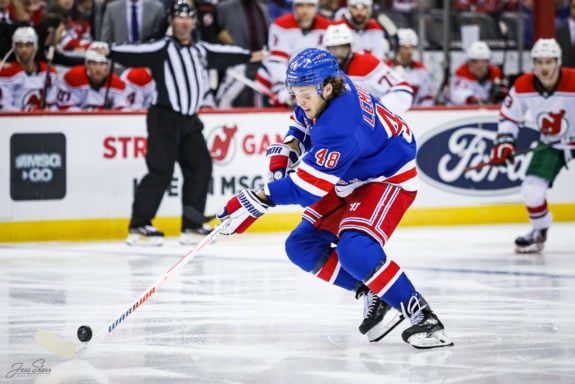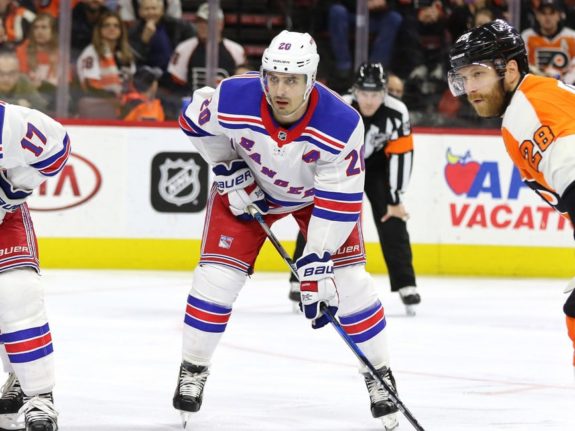If the Stanley Cup Final between the Tampa Bay Lightning and Dallas Stars is any indication, size and physicality are still prevalent in today’s NHL. Each game has seen at least 100 hits, with Game 3 setting the high mark of 113.
The level of physicality in this series should come as a surprise to no one. Brady Skjei set the tone just 28 seconds into the playoffs’ opening game with a massive hit on Jesper Fast, paving the way for what has been a ferocious postseason.
Related: The Rangers’ Family: 4 Sets of Brothers in Blueshirts
The Rangers model their game on speed and skill, but the postseason, grit, and tenacity become equally important. Tampa has finally adjusted, surrounding their skill players with gritty veterans such as Pat Maroon and Barclay Goodrow. New York would be wise to follow that model, and luckily for them, their youth possess the size to do it.
The Size Is Already Here
In 2019-20, Brendan Lemieux seemed to be the only forward willing to engage the dirty areas and play with a necessary edge. One may think that the Blueshirts need to look toward the open market to add physical forwards, but they have a rare combination of size and skill with their current depth forwards.
Julien Gauthier, a 22-year-old acquired via trade last season, is 6’4 and 227 pounds. Brett Howden, a player who has underperformed statistically, is 6’3 and 197 pounds. Tim Gettinger, who played two games in the NHL last year, is 6’6 and 218 pounds. Even Filip Chytil (6’2, 206) and Kaapo Kakko (6’3, 199) possess the size and strength to wear a team’s defense down.

Perhaps the most significant factor in the Rangers’ success moving forward is their ability to handle the more physical opponents. The size is there, but the ability to properly use it still eludes this young forward group.
This offseason, the emphasis has to be put on strength training, forcing these young players to bulk up and wreak havoc on the NHL next season. New York used the prototypical fourth line of big-bodied checkers during successful seasons of the past to impact a series. Now they have tossed aside the notion of a ‘grind-it-out’ fourth line and adapted a fourth line that possesses the size and skill to be physical yet useful.
We have seen the New York Islanders get immense production from their fourth line, with Casey Czikas, Matt Martin, and Cal Clutterbuck. Martin led the bunch with 242 hits, 69 more hits than the Rangers leader in Lemieux. (from ‘Rangers should pursue Islanders’ Matt Martin under one condition,’ New York Post, 09/19/2020) Despite my belief that the Rangers need to utilize the body more, I am not suggesting they run around the ice looking to create contact.

So how could the Rangers use their youth’s size to their advantage?
Utilizing Size and Speed
Simply put, the fourth line with Howden centering Gauthier and Lemieux lacks the talent level to produce continued offense. Yet, an emphasis on the forecheck could allow these big boys to wear down a defense and open up the ice for themselves and their teammates.
While all the attention goes to the stars and shiny offensive players, these three Rangers will be crucial to the team’s success next season. And with Gettinger waiting in the wings, a lackluster performance from anyone on this line could mean their departure from the lineup.
Outside of the role players, the Rangers skilled forwards have to use their size and speed to create more offense. We have seen what the likes of Artemi Panarin and Mika Zibanejad could do for New York, but veteran’s Chris Kreider and Pavel Buchnevich, as well as young bucks Kakko and Chytil, have to show that they can be quality second options for the Blueshirts.

At 6’3 and 217 pounds, Kreider has been a force in the NHL for eight seasons. He has explosive strides and a big frame, utilizing his size and speed to his advantage, serving as a prototype for Chytil and Kakko. If the Kakko (19) and Chytil (21) could start to use their bodies like Kreider, the Rangers could become one of the most formidable NHL teams to defend.
The wild card in this group is Buchnevich, who, at 6’3 and 197 pounds, should be able to create more than he does. Alongside his younger teammates, he must commit to developing his strength and increasing his physicality in 2020-21.
The Influx of Size Keeps Coming
According to James Mirtle of The Athletic, the average size of an NHL player in 2019-20 was 6-foot-1. (from ‘Sizing up the NHL: 2019-20 NHL teams by age, height, weight and nationality,’ The Athletic, 10/09/2019) In 2019-20, the Rangers had 14 skaters at 6-foot-1 or taller. Standing at 6-foot-1, consensus first overall pick Alexis Lafreniere would only add to that list. Not to mention, K’Andre Miller (6’5), Vitali Kravtsov (6’3), and Morgan Barron (6’4) will all be fighting for roster spots this season as well.
Related: One for the Ages – Sergei Zubov’s 1993-94 NHL Season
The Rangers are quickly and quietly becoming one of the biggest teams in the league, which also comes with speed and skill. The skill and talent are there, but if these young Blueshirts can utilize their size as well, the NHL is going to have a problem containing the Rangers for years to come.